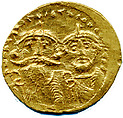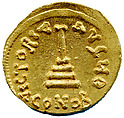Returned to lender The Met accepts temporary loans of art both for short-term exhibitions and for long-term display in its galleries.
Imitative Solidus of Byzantine Type
Not on view
The Byzantine Empire issued the gold solidus, or nomisma, used primarily for large transactions such as tax payments, and several denominations of copper coins, the money of daily business transactions. Mints in Antioch and Alexandria supplied the majority of the coinage circulated in the southern provinces. The newly established Arab government inherited an efficient monetary system and made few changes during its first decades. The caliph ‘Abd al-Malik (r. 685–705) introduced several issues of distinctively Islamic coinage.
The first Umayyad caliph, Mu‘awiya (r. 661–80), issued gold and silver coinage. A contemporary chronicle reports that soon after he was proclaimed caliph in Jerusalem he issued gold and silver coins that the local population rejected because they did not bear the sign of the cross.
This close imitation of the Solidus of Heraclius and Heraclius Constantine lacks the crosses above the heads of the emperors and the cross bar from the cross-on-steps on the reverse.
Due to rights restrictions, this image cannot be enlarged, viewed at full screen, or downloaded.
This artwork is meant to be viewed from right to left. Scroll left to view more.



